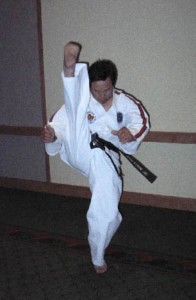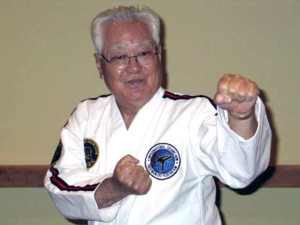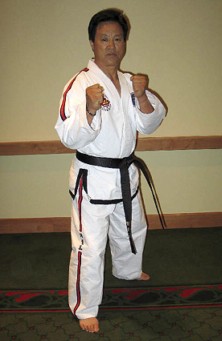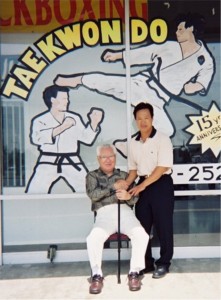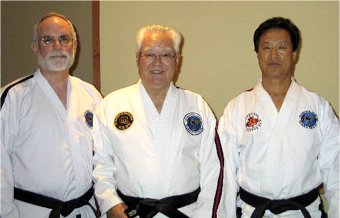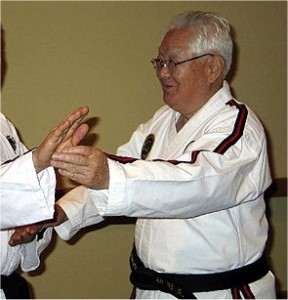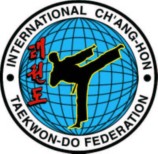ARTICLES |
An interview with Grand Master Kong Young Il, IX degree By Stuart Anslow III |
Having left a Taekwon-do federation a few years back due to political wranglings,
which seems to be getting ever worse, I was admittedly hesitant when a friend of mine informed me of the International Ch'ang Hon Taekwon-Do Federation, as obviously, I had previously jumped out of the frying pan and was happy how I was, so didn't want to jump back into the fire. Those who know me will attest, I have no interest in being caught up in the political situations of Taekwon-do or martial arts at all, preferring just to train & teach, making many good friends, who feel the same, along the way. However, the names associated with this organization caught my attention. Names from a who's who's of Taekwon-do history! Grand Master Nam Tae Hi was the first name that caught my attention, as Grand Master Nam was there at the beginning; he was there with General Choi and is known as 'the first instructor of Taekwon-do'. Other highly noted names such as Kong Young Il, C K Choy, J C Kim & Kong Young Bo were also associated with this organization, so I felt compelled to investigate. Upon further investigation, I found out that the president of this organization was Grand Master Kong Young Il, 9th degree, formerly of the ITF. Grand Master Kong is a 1st generation student of General Choi, so even though in the UK he is not as well known as other ITF notable's such as Grand Master Rhee, Ki Ha, Master Park, Jung Tae & Master Hee, Il Cho, he has the same superb lineage. I contacted Nancy Stanley who was very informative with my many questions about the ICTF & its policies. Eventually I decided to go straight to the source, so I asked Nancy if she could arrange an interview with none-other than the ICTF President himself, Grand Master Kong Young Il, 9th degree! A brief biography of Grand Master Kong, Young Il, 9th Degree Grand Master Kong, Young Il was the Taekwon-do All Star Team Captain at Kyung Hee University, South Korea in 1963. He was in the Republic of Korea Army from 1964 to 1968 where he was again the Taekwon-do All Star Team Captain. During those years, he was also the first Master Instructor to Introduce Taekwon-do to the 8th US Army in Korea. During 1963 to 1980, Grand Master Kong traveled around the world with General Choi Hong Hi, as a selected member of an International Tae Kwon Do demonstration team. He visited 127 countries performing demonstrations to introduce Taekwon-do Martial Art to the world. After each demonstration there was an open invitation/challenge to the public to fight any demonstration team member. Grand Master Kong fought martial artists of all kinds in 127 countries and never lost a fight. Throughout 1980 to 2004, Grand Master Kong opened Taekwon-do Dojangs from the East Coast to the West Coast of America as well as Puerto Rico and taught Taekwon-do to thousands of practitioners. Quite a few of his students became champions around the world. One noteworthy highlight was his being Master Instructor for the USA government agency, the FBI. Amongst his awards, Grand Master Kong has been awarded the All American Open Award, inducted into the Hall Of Fame and been voted Martial Artist of the Year. (Biography taken from the ICTF web site www.ictf-web.com) The Interview Stuart Anslow: Grand Master Kong, thank you for agreeing to be interviewed today! Grand Master Kong, Yong Il: I am honored you have asked me to be interviewed. Please feel free to ask any questions you wish Stuart Anslow: How many years have you practiced Taekwon-do? Grand Master Kong, Yong Il: I have been practicing Taekwon-do for 52 years Stuart Anslow: Thats a long time, when did you start? Grand Master Kong, Yong Il: I started at nine years old in 1952 Stuart Anslow: And what rank do you hold now? Grand Master Kong, Yong Il: I am a ninth degree black belt Stuart Anslow: When did you turn 9th degree & how was it awarded? Grand Master Kong, Yong Il: When I went to Poland in 1997, General Choi promoted to 9th degree at that time. I am also 9th degree black belt through the Oh Do Kwan. President Jin Duk Young promoted me in 1994. Stuart Anslow: Have you done any other martial arts? Grand Master Kong, Yong Il: I practiced Judo while I was in Kyung Hee University Physical Education College during the years 1962 - 1967. It was mandatory for me to do this for my curriculum (sp?). Stuart Anslow: How did Judo compare to Taekwon-do back then? Grand Master Kong, Yong Il: I did not really enjoy Judo. I had to take it for my curriculum. My true enjoyment lay in Taekwon-Do. Stuart Anslow: How did you get involved in Taekwon-do? Grand Master Kong, Yong Il: When I was nine, I was passing by a Karate school, at that time there was no Taekwon-Do yet. I saw the students punching and kicking and I could hear them yelling and it attracted me so I went in and talked to the Instructor. I started training the next day. Stuart Anslow: What style of karate was that? Grand Master Kong, Yong Il: Shotokan Stuart Anslow: What are your Taekwon-do roots (ie which kwan?) and when did you joined the ITF? Grand Master Kong, Yong Il: General Choi, Hong Hi and Grand Master Nam, Tae Hi established Oh Do Kwan in the year approximately 1953 Stuart Anslow: And did you change from Karate to Taekwon-do (Oh Do Kwan) at this time? Grand Master Kong, Yong Il: The main members of the Oh Do Kwan were soldiers from the Korean Army. Chung Do Kwan was another organization which consisted mainly of civilians, but it was the same style as Oh Do Kwan. These two organizations were the driving force to form the ITF by General Choi, GM Nam and others. Stuart Anslow: Did you change from karate to Taekwon-do at this time (ie. 1958/59)? And why did you choose to change? Grand Master Kong, Yong Il: I moved to Won Joo, Korea in 1958. This was where Oh Do Kwan began. Tae-geuk (1, 2, 3) and Pyung Ann (1, 2, 3, 4, 5) were the patterns that we practiced at that time. It was still considered Karate. I enjoyed it very much. All the patterns Stuart Anslow: Were this directly under General Choi? Grand Master Kong, Yong Il: Yes and GM Nam Tae Hi. Stuart Anslow: What was the 'All Star Team' at Kyung Hee University? Grand Master Kong, Yong Il: In this University which consisted of over 35,000 students, I was one of the members selected to receive a full scholarship for Taekwon-Do and to participate on the All star team. Stuart Anslow: Was this a competitive team or a display team? Grand Master Kong, Yong Il: Yes, it was a competitive team. Stuart Anslow: I understand you served in the Korean army? What was that like? Grand Master Kong, Yong Il: I served in the Republic of Korea Army from 1963-1967. My role within the Army was to further enhance the training of other Taekwon-Do Instructors to ensure they were qualified to be sent to Vietnam to spread Taekwon-Do further. I was also on the All-Star team while in the Army competing with many other teams. University teams, air force and marine and so on. Stuart Anslow: What was the Taekwon-do training like in the army? Grand Master Kong, Yong Il: (Laughing) Get up in the morning 5:30am and went running until 6:30am. Then we had breakfast. At 9:00am we had a training session until 12:00 practicing our techniques. Then lunch. From 2:00-5:00 we trained in free sparring. After that I went to the US Army Base to teach the soldiers and the soldiers families Taekwon-Do. That usually lasted until 9:00pm Stuart Anslow: What was free sparring & patterns training like in the army? Grand Master Kong, Yong Il: It was very severe training. We were not allowed to fool-around at all. We worked very hard every minute. I was the captain and it was up to me to ensure they were working all the time. In order to do that, I had to practice myself just as hard. Stuart Anslow: Was it like free sparring today (ie. light contact)? Grand Master Kong, Yong Il: We did not have sparring equipment. We had light contact....my shins were always very bruised from practicing. It was very similar to how we practice today but we did not have anything protecting our bodies. We learned to block very well because if we did not, it would really hurt because we had to padding on our bodies. Stuart Anslow: Did you practice the applications of the techniques contained in the patterns or just each pattern as a whole? Grand Master Kong, Yong Il: Whole patterns all the time Stuart Anslow: Did you hold a rank in the army? Grand Master Kong, Yong Il: Just a Sergeant. Private first class, then Corporal then Sergeant Stuart Anslow: Did you ever serve in Vietnam? Grand Master Kong, Yong Il: No Stuart Anslow: Were you a part of the original ITF since its inception in 1966? Grand Master Kong, Yong Il: Yes Stuart Anslow: How has Taekwon-do training changed since then? What has been lost or gained? Grand Master Kong, Yong Il: In the early 70s, we had more than 20,000,000 practitioners in the ITF. It was a dictatorship run by General Choi, Hong Hi. I still teach my students the same way I was teaching back then but obviously not with intensity of the training that I was used to. Times have changed. Stuart Anslow: I understand, during the Taekwon-do demonstrations you traveled with General Choi & after demonstrations the Demonstration team were open to challenges from other martial arts and that you had 127 fights & never lost any? What was it like, all those challenges? Grand Master Kong, Yong Il: Yes, I never lost any of my fights. None of the members on General Choi's team lost their fights. We showed the world that Taekwon-Do was the strongest martial art. I am not sure exactly how many fights we did, I just know we did not lose any. Stuart Anslow: Apart from Taekwon-do, what other areas/skills have you interests in? Grand Master Kong, Yong Il: My hobby is golf. I have brother in Korea who is a professional golfer. I try to play one per week but right now I am putting all of my energies into my new school in Las Vegas and in the ICTF. Stuart Anslow: What do you think of the ITF organizations now? Grand Master Kong, Yong Il: Since General Choi's health began to deteriorate, many of the senior instructors of Taekwon-Do appeared to be maneuvering for positions of power and favours. Now that the General has passed away, the ITF has split into three different organizations all claiming to be the "true" or "rightful" one. Stuart Anslow: What do you think of the current ITF situation? What is going on there with 3 organizations claiming to be the ITF? Grand Master Kong, Yong Il: I think it is obvious that with three organizations all fighting for power, they certainly can not be focusing on the members needs. The focus of an organization should be in supporting, educating and servicing its membership. Stuart Anslow: Is that why did you left the ITF organization you were in and formed the ICTF? Grand Master Kong, Yong Il: I did not leave the ITF to from any organization. I left the ITF along with many other faithful members due to the disappointment in how it was being lead. Stuart Anslow: Whose idea was it to form the ICTF? Grand Master Kong, Yong Il: Grand Master CK Choy and Grand Master JC Kim (both from Vancouver, Canada) and Grand Master Nam Tae Hi (presently living in LA, USA) and I all felt that the existing organizations were not "true" to its members. As pioneers of Taekwon-do and all members of the original Taekwon-do Demonstration Team with General Choi, we felt it was time to form an organization for the members to carrying on the General's legacy. Another good friend of mine from Spain, Master Kim Mu Won, who was my student in the 60s, also came on board along with Grand Master Park Bu Kwan from Texas and Master Kong, Young Bo (from Pennsylvania - who was the first ITF World Champion in 1974). Together we had to tools and experience to ensure a very strong organization which focused on its members and further Taekwon-Do techniques. We all got together and had a meeting in February 2003 and formed the WITF and then went on to change the name to the International Ch'ang-Hon Taekwon-Do Federation. It was officially established on October 23, 2003. Stuart Anslow: Are Grand Master CK Choy, Grand Master JC Kim, Master Kim Mu Won, Grand Master Park Bu Kwan, Master Kong, Young Bo as well as Grand Master Nam Tae Hi all part of the ICTF? Grand Master Kong, Yong Il: Grand Master Nam Tae Hi is the honorary president of the ICTF. CK Choy and JC Kim are both retired but act in an advisory capacity to myself. Grand Master Park Bu Kwan is acting chair of the Technical Committee for the ICTF. Earlier in his Taekwon-do career, he was on the Korean army all star team and he was awarded the Best Fighter of the Year in 1967 from the President of Korea, Park, Jung Hee. Master Kong, Young Bo, who has received over 100 Grand Champion titles of open championships throughout his career, is the acting chair of the Ethics/Discipline Committee of the ICTF. In 1974, at the first ITF World Champions in Montreal, Canada, Master Kong won the Grand Champion Trophy. Stuart Anslow: What is the philosophy & principles behind the ICTF? And how does it differ from the ITF & other organizations? Grand Master Kong, Yong Il: The easiest way to answer this is to start with other organizations. They run from the "top". One person, or a small group of people, run the entire organization and receive the benefits from it. The member's on-the-other-hand seems to just be a source of income and nothing more. The ICTF is very different from this type. First of all, every member that joins receives a membership package containing an ICTF flag, an Etiquette book, a certificate, wallet card, lapel pin, ICTF crests and more. We begin by giving them materials and information. No other organization that I am aware of offers this. Also, every member has voting rights. This is critical. Other organizations say they run democratically but in fact, decisions are made at the top and told to its members. With the ICTF, the members all have input into decisions. The more minds and experience you bring together, the stronger the organization. We have truly come together to promote Taekwon-do throughout the world and assist instructors and students any way we can. Stuart Anslow: How is the ICTF growing? Roughly how many members has it now? Grand Master Kong, Yong Il: Since its inception in October 2003, we have members in Canada, USA, Spain, UK and Hong Kong. We are currently providing information to other Countries that have inquired about membership. At this point, Master Steiner, 8th Dan comes on the phone, so I take the opportunity to ask him a few questions too! Stuart Anslow: Master Steiner how did you became involved with the ICTF? Master Steiner: I became aware that the pioneers of Taekwon-Do were coming together to form a new organization to maintain the principles of the Ch'ang-Hon system. I had been involved in other Taekwon-do organizations previously and was extremely unhappy with the decision making process (from the top-down). Stuart Anslow: What is your role in the ICTF? Master Steiner: I am the Executive Vice-President and my role is to liaise with all committees of the ICTF and I also on the technical committee. I report to the President and to the membership. After Master Steiners short conversation, I continue interviewing Grand Master Kong Stuart Anslow: What do you think of WTF & WTF Taekwon-do? Grand Master Kong, Yong Il: WTF is actually an organization not a style. I believe that their president is currently in jail. This is just another example of how politics and corruption has infiltrated the martial arts organizations. Again, the ICTF was formed to get back to the roots of teaching Taekwon-do and not politics. Stuart Anslow: Does the ICTF support the 'merge' situation like some of the ITF groups do? Grand Master Kong, Yong Il: Do you mean ITF merging with WTF? Stuart Anslow: I mean a Ch'ang Hon style group, not necessarily the ITF/s themselves! For example, if the door was opened, would the ICTF want to do that? Grand Master Kong, Yong Il: My vision is to bring all Ch'ang-Hon practitioners together to share techniques through competition or training camps. The ICTF's goal at the present time is not the Olympics, but rather to establish a strong member driven organization with experienced, certified instructors and quality tournaments and seminars. Stuart Anslow: The ICTF has generated a lot of interest in the UK, simply through word of mouth. Are there any plans for yourself and any of the other masters to visit the UK this year to promote the ICTF & host seminars etc.? Grand Master Kong, Yong Il: Yes, we have tentatively two seminars in November. one in the North and one in the South of England. Stuart Anslow: Excellent. I have seen the colour belt certificates, they are very nice but what does the writing on side of colour belt certificates say? Grand Master Kong, Yong Il: This is a calligraphy of the tenets that was done by General Choi, Hong Hi who was well known throughout Asia for his calligraphy. Stuart Anslow: What countries, in your opinion, are leading the way in Taekwon-do? What makes them so good? Grand Master Kong, Yong Il: That is very difficult to answer as many countries are very strong in Taekwon-do. Stuart Anslow: Okay, what do you think of the general state of Taekwon-do now? Grand Master Kong, Yong Il: A little bit confusing. What I mean by this is it seems so many are seeking their own benefits and glory from Taekwon-do and the real martial art has been lost. I don't mean to bring this up again, but that is why the ICTF has been formed, to get back to the roots of Taekwon-do. Stuart Anslow: Do you think that General Choi`s original vision of Taekwon-do has been lost? Grand Master Kong, Yong Il: I can not speak for General Choi. Only he knew what his vision was. Stuart Anslow: Politics aside, what do you think of the North Korean Taekwon-do, from a technical view point? Grand Master Kong, Yong Il: North Korean is not its own style of Taekwon-do. Taekwon-Do is a Korean martial art, are you asking what I think of it technically? Stuart Anslow: Yes, from a technical view point only Grand Master Kong, Yong Il: I think it is the most precise martial art available today. There is an exact position for optimum blocking, punching and kicking. This makes it easier for the instructor to teach their students. You know exact angles of feet etc. Sine wave when executed properly allows the practitioner to gain more power and balance. Sine wave is exclusive to our style of Taekwon-do and they make us stand apart from all other martial arts. Stuart Anslow: Do you support the notion that the sine wave means you drop, rise & drop again or simply as its placed in the manual as an up/down curved motion? Grand Master Kong, Yong Il: This is difficult to put into words. I have seen many students who do not completely understand sine wave and over exaggerate it. This is a technique that needs to be taught and practiced properly for it to be effective. Stuart Anslow: What is your theory of power? How can techniques be performed with more power, whilst not slowing it down? Grand Master Kong, Yong Il: Use the entire body. With precise timing and speed you can create the most power in your techniques. It is very important to utilize many parts of the body together. For example, when executing a punch, you would not just use your arm and fist but rather create power with movement of your entire body with "focus" of power in one direction. Stuart Anslow: What is more important in a technique, speed & accuracy or more power? Grand Master Kong, Yong Il: Speed and accuracy create power Stuart Anslow: How important is it for a student to understand the applications of patterns in Taekwon-do? Grand Master Kong, Yong Il: That is very important. From practicing you will learn proper technique, balance and focus. If you do not understand the application of your move within your pattern, then there would be no true understanding of what you are executing. Stuart Anslow: Has Taekwon-do many hidden applications, like those in the karate world feel are hidden in kata's? Grand Master Kong, Yong Il: I do not believe there are hidden techniques. Taekwon-do is a very precise martial art and every action is explainable by any good instructor. Stuart Anslow: Many students run through the patterns and are never taught proper applications, often because there instructors are not taught them either, for example the twin palm pressing blocks in Joong-Gun is questioned quite a lot, as its shown as a block for a kick & punch at the same time! What is this movement for? Grand Master Kong, Yong Il: To defend against two people, one is punching and one is kicking. It is performed slow only for interpretation but in application it would be performed normal speed Stuart Anslow: Also, 9-shaped block? Grand Master Kong, Yong Il: The 9 shaped block is performed to break someone's arm who is holding onto your lapel or to defend against a kick or a punch. In reality, a block can also be an offensive move. Stuart Anslow: Some instructors teach different applications for the same technique, for example, the twisting hands motion in Yoo-Sin I have learnt as a trapping technique & also as a wrist lock technique, which is correct? Grand Master Kong, Yong Il: In this particular pattern, it was never made clear to me by General Choi exactly what the application of this move is (within the pattern). However, this certainly does not mean that it can not be used for many other applications. Stuart Anslow: Another quizzical motion in patterns is the six 'W' blocks in Toi-Gye? What are they actually for & why are they repeated so many times? Grand Master Kong, Yong Il: They are designed to defend against attacks from the side. One is blocking with the inner forearm and the other is blocking with the outer forearm. This is performed in a stamping motion. There is no purpose for this stamping motion other than to generate more power to the arms. Why are they repeated so many times you ask? Because General Choi says so! (Grand Master Kong laughs) Stuart Anslow: Were you involved in the formation of the ITF patterns? If so, which ones & in what respect? Grand Master Kong, Yong Il: As the General was creating the patterns, there were a group of us with him performing and perfecting them together. Stuart Anslow: Any in particular? Grand Master Kong, Yong Il: No one pattern in particular. We worked on many of the patterns as a group with General Choi Stuart Anslow: Have you visited the UK much? Grand Master Kong, Yong Il: In 1973 I was in the UK with the world demonstration team. Again in 1975, I was there doing another demonstration at a tournament hosted by GM Rhee, Ki Ha. I was there with CK Choy, and JS Park. Stuart Anslow: What do you think of high ranking UK masters like Grandmaster Ki Ha Rhee? Grand Master Kong, Yong Il: Are you asking only about UK masters or all high ranking master? Stuart Anslow: UK! Grand Master Kong, Yong Il: I have respect for many Taekwon-do instructors throughout the world. We have all worked very hard along with General Choi to spread Taekwon-do. Stuart Anslow: Do you have any children or Grand children? If so, do they practice Taekwon-do? Grand Master Kong, Yong Il: I have two sons. One is 25 and his name is Andy and my other son is Douglas and he is 24. They are both 2nd degree black belts. Stuart Anslow: What memories do you have from your early training years that you could share? Have you any stories that you can share with the readers? Grand Master Kong, Yong Il: I loved to learn. It was so much fun training with my friends and learning daily from my instructor. In Korea, when we were training, the floor was soooo cold we could not stand in one place too long. We had to constantly be moving and practicing. (He is laughing!!!) In the summer, it was so hot that we would squeeze the sweat from our uniforms more than once during our practice. Stuart Anslow: What made you move to America? Grand Master Kong, Yong Il: When I was teaching the USA army one of the high ranking soldier was my student. He sent me an invitation to come to the USA. At that time I was making a comfortable living in Korea and did not want to come. But, he convinced me to see the world, not just stay in Korea. In Korea, there are restrictions going to other countries. If you lived in the USA, you could travel anywhere. That is what convinced me to move. I had a vision to introduce Taekwon-do to the world and did not like the restrictions that Korean had on traveling to other countries. Stuart Anslow: I understand you were the master Instructor for the FBI? What was that like & did you teach them all Taekwon-do or just parts of it? Grand Master Kong, Yong Il: I taught them the entire set of patterns just like I teach my students now. Not just self-defense, but all aspects of the patterns and sparring too. Stuart Anslow: Do you still hold that position? Grand Master Kong, Yong Il: No. Stuart Anslow: How can people find out more about the ICTF? Grand Master Kong, Yong Il: They can visit the ICTF web site at www.ictf-web.com or contact us via e-mail at admin@ictf-web.com or call toll-free 1-877-301-9069. Stuart Anslow: Finally, what does the future hold for Taekwon-do, the ICTF & yourself? Grand Master Kong, Yong Il: A good friend of mine who is involved in the ICTF once said to me a couple of months ago "The future is so bright you have to wear shades". At first I did not understand what she meant. She had to explain it to me. (Kong laughed). But now I know that the comment was very true as we are getting nearly overwhelming amounts of interest in the ICTF. As for myself, I will continue to train and teach Taekwon-Do as well as continue to move forward with the ICTF along with the support and the experience of the membership. Stuart Anslow: Grandmaster Kong, I would like to thank you for taking the time to share your views, thoughts & feelings on Taekwon-do with me and for being very frank & honest even though I asked some difficult questions. It has been a pleasure & a privilege to interview you & I'm sure the ICTF is going to do great things for Taekwon-do students & instructors around the world. I look forward to meeting you next time you are in the UK. Grand Master Kong, Yong Il: Thank you, I am equally honoured to give this interview. Stuart Anslow is instructor of Rayners Lane Taekwon-do Academy (www.raynerslanetkd.com) that teaches Taekwon-do as it was originally perceived, as a military based martial art, he is also a lead force with in the International Alliance Of Martial Art Schools (www.iaomas.com) which promotes unity in martial arts on an international scale. |
As printed in taekwon-do & Korean Martial Arts Magazine - November 2004 |
